
Introduction
Out of their pretty extensive range it has been Dell's UltraSharp
monitors which has always attracted the most attention over the years, with a
great selection of sizes available, featuring high end panel technologies, specs
and features. We've seen a lot of excitement when a new U-series screen arrived,
most recently with the release of the
27" U2713HM and
the news that we expect to see a refreshed 24" U2413 and 30" U3013 model
some time early next year. The rest of Dell's extensive monitor line-up is
normally reserved for lower cost models, with trimmed down feature sets and
normally lower cost TN Film panels. However,
recently Dell have released their new S-series range (the "S" stands for
"studio" by the way), offering models of 21.5, 23, 24 and 27". Unlike their
other lower cost models, these all feature higher end IPS (or AMVA in the case
of the 24" model) panels and so are designed to be a mid-way solution, offering
some higher end specs and technologies but while still maintaining a very low
cost.
We will feature reviews of the other S-series
models in the near future but for now we have the 24" S2440L with us for
testing. This screen features an AMVA panel and offers a decent spec. Its connectivity
and stand adjustment options are certainly more limited than the 24" UltraSharp
models like the
U2410 and
U2412M, but it does come with a "frameless" edge-to-edge glossy glass front
which some users have been shouting out for from more desktop monitors.
Dell's website says: "Dive
into brilliance with the distinctive S2440L 24" monitor, featuring ultra-wide
viewing, edge-to-edge glass and our Image Enhance feature. Images come alive
with colour-boosting Image Enhance, ultra-wide viewing and Full HD resolution
(1920 x 1080 max.) in a 16:9 widescreen format. Connect to a laptop or desktop
with VGA connectivity. Explore a world of HD entertainment options with an HDMI
port."

Specifications and Features
The following table gives detailed information
about the specs of the screen:
|
Monitor
Specifications |
|
Size |
24"WS (60.97cm) |
Panel Coating |
Glossy Glass coating |
|
Aspect Ratio |
16:9 |
Interfaces |
HDMI, VGA |
|
Resolution |
1920 x 1080 |
|
Pixel Pitch |
0.277 mm |
Design
colour |
Glossy black bezel and base, silver stand |
|
Response Time |
6ms G2G |
Ergonomics |
4°
- 21°
Tilt adjustment only |
|
Static Contrast Ratio |
5000:1 |
|
Dynamic Contrast Ratio |
8
million:1 |
VESA Compatible |
No |
|
Brightness |
250 |
Accessories |
Power cord and block, D-sub cable, cable tie |
|
Viewing Angles |
178/178 |
|
Panel Technology |
AMVA |
Weight |
With stand: 4.95Kg |
|
Backlight Technology |
W-LED |
Physical Dimensions
|
WxHxD with stand
567.4 x 417.9 x 190.8 mm |
|
Colour Depth |
16.7m (8-bit) |
|
Colour Gamut |
Standard gamut, sRGB
~72% NTSC |
Special
Features |
Audio out connection |
Manufacturers website link:
Dell
The feature set of the S2440L is certainly more
limited than the popular UltraSharp models available. There are only 1x D-sub
(VGA) and 1x HDMI connections available for video connectivity. There is no DVI
and so you will need a DVI > HDMI cable or adapter if you want to connect from a
DVI port on your graphics card. There is also no DisplayPort connection which is
becoming increasingly popular nowadays. There is an audio out connection on the
back of the screen if you want to listen to the sound sent over HDMI (if using
HDMI end to end), but there are no integrated speaker on this model. While it is
not listed in their specs, checking our graphics card control panel confirms the
HDMI interface supports HDCP for encrypted content.
The screen comes packaged with only a D-sub VGA
cable, and there is no HDMI cable provided since costs are being kept at a
minimum here. The screen features an external power supply brick which comes
packaged as well. There are no extra features here like USB ports or card
readers, which are featured on some UltraSharp models from Dell.
Below is a summary of the features and connections of
the screen:
|
Feature |
Yes / No |
Feature |
Yes / No |
|
Tilt adjust |
 |
DVI |
 |
|
Height adjust |
 |
HDMI |
 |
|
Swivel adjust |
 |
D-sub |
 |
|
Rotate adjust |
 |
DisplayPort |
 |
|
VESA compliant |
 |
Component |
 |
|
USB Ports |
 |
Composite |
 |
|
Card Reader |
 |
Audio connection |
 |
|
Ambient Light Sensor |
 |
HDCP Support |
 |
|
Touch Screen |
 |
Integrated Speakers |
 |
|
Hardware calibration |
 |
Uniformity correction |
 |

Design and Ergonomics

Above:
front view of the screen. Click for larger version
The S2440L comes in a pretty much all-glossy
design. The front of the screen and the base of the stand are both glossy.
Black plastics are used for the edge bezel of the screen and for the
squared base of the stand. The bezel does not protrude at the front of the
screen and so the entire front is flat, giving the "frameless" design that
quite a few manufacturers are starting to promote. There is of course a
bezel along the sides of the panel and in the case of the S2440L this
measures ~18mm along all edges. With the edge-to-edge coverage, you
can use these screens quite nicely for side by side multi-screen setups as
shown below.
The monitors arm is a matte silver plastic. A shiny silver Dell logo is situated on the front of the screen in
the middle of the lower bezel, but no other writing is present around the
other edges. The OSD operational buttons are located on the bottom right
hand edge with a subtle grey coloured power logo, and 4 small grey
circles. These controls are touch-sensitive and we will look at this
in more
detail shortly.

The front of the screen is covered with a
glossy edge-to-edge glass
screen coating which produces a strong reflection. It makes the screen
look quite attractive when set on the desk, but it is a very reflective
screen surface, more so even than a normal glossy panel coating. It is
also good as a protective, hard layer in front of the panel.
The glossy finish provides a very different
feel to normal matte AG coatings. It can make colours and blacks "pop" and
the image feels very different. However, it can often introduce
distracting reflections when it is used, and it's no exception here on the
S2440L. In fact I would say it is more reflective than many other glossy
screens we have used and buyers should be wary of this if they have
windows or lamps nearby which could become problematic. It is the glass
coating which is accentuated this glossy feel here. It can also become a
pain with finger prints and smudges, so keep a cleaning cloth handy!

The stand comes dismantled in the box but is
easily clipped together. The arm slots into place on the base and is
tightened as shown above using the small thumb screw. The arm then easily
slots into the back of the monitor where a release button is also provided
if you ever need to take the arm off. The screen is not however VESA
compliant, and so is not mountable separately unfortunately.
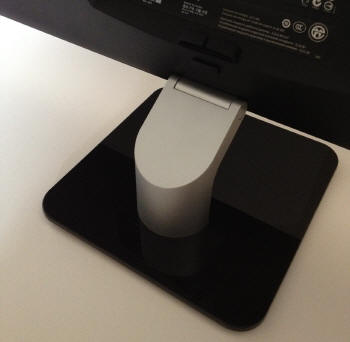
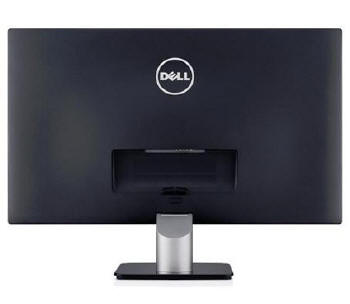
Above: view
of the base and rear of the display. Click for larger versions
The back of the screen has a rounded black
matte plastic finish, with a Dell logo at the top as shown. The video
connections are housed within a small inset section at the back. There is
a small cable tidy clip provided to position the cables out of the way
behind the arm of the screen. A further cable tie is provided in the box
to help keep things neat if needed.

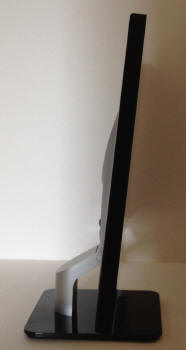
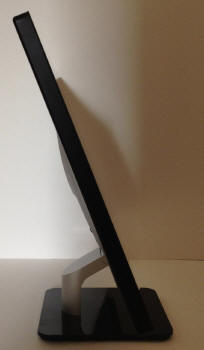
Above: side
views showing profile and full tilt range. Click for larger versions
The screen has a nice thin profile from the
side thanks to the use of W-LED backlighting and an external power brick.
The stand provides only a basic tilt adjustment with a range of -4° to 21°
provided. This is smooth and easy enough to manoeuvre thankfully and it
offers a decent range. There is sadly no height, swivel or rotate
adjustment available as Dell have opted for a more basic, and lower cost
stand to keep retail costs of the S-series down. The screen is fairly
wobbly when being moved but remains stable enough on the desk when it's
not. The bottom edge of the screen is ~80mm above the height of the desk
when vertical.
A summary of the screens ergonomic adjustments
is shown below:
|
Function |
Range |
Smoothness |
Ease of Use |
|
Tilt |
-4° to +21° |
Smooth |
Easy |
|
Height |
n/a |
|
|
|
Swivel |
n/a |
|
|
|
Rotate |
n/a |
|
|
|
Overall |
Only tilt available but easy to use and
smooth movements. |

Above:
schematics for the S2440L. Click for larger version
Materials were of a high quality and the build
was good. There was no audible noise from the screen during use and it also
remained nice and cool thanks to the W-LED backlight unit. A full screen
dimensions and measurements diagram is provided above for reference as well.


Above: view of
interface connections. Click for larger version
The back of the screen features the interface
connections shown above. There are video connections for HDMI and D-sub, along
with an audio output for if you are using the HDMI and sending audio to the
screen as well. The connection on the far right of the above image is for the
external power brick.

OSD Menu
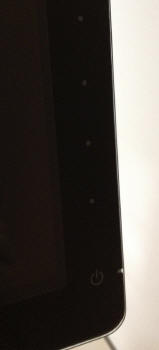
Above: view of OSD operational buttons. Click for larger version
The S2440L features touch sensitive OSD control
buttons which are located on the bottom right hand edge of the screen as shown
above. These do not light up like they did on some older Dell models (e.g.
U2410) but work nicely and are sensitive.
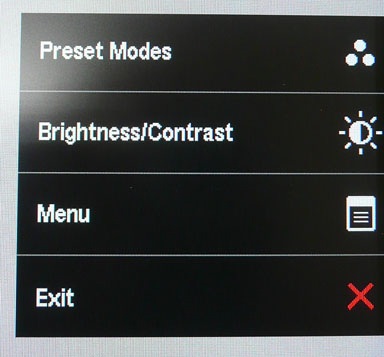
Pressing any of the 4 buttons brings up the quick
launch menu, giving you quick access to preset mode selection and brightness /
contrast controls. You can also select to enter into the main menu, or simply
exit the quick launch menu. You can in fact personalise the two quick launch
options from within the main menu should you wish to. Within the preset modes menu there are options for
standard, multimedia, movie, game, text, warm, cool and custom colour.

Bringing up the main menu presents you with
various sub-sections down the left hand side as shown. At the top right, like on
other recent Dell screens, there is an "energy use" bar which gives you a visual
indication of the power consumption at any given time. This is based on the OSD
brightness setting which controls the backlight intensity, and therefore has a
direct correlation to the power consumption. The brightness/contrast section is
self explanatory of course. The second section for "auto adjust" is only
relevant when using the analogue D-sub connection and is greyed out when using
digital HDMI.

The input source section allows you to manually
select which interface is in use. There is also a handy 'auto select' mode which
will switch to whichever interface is active.

Colour settings allows you to change a couple of
settings relating to colour format, but perhaps more useful here is
access to the preset colour modes. There is also an 'image enhance' option here
which serves to artificially exaggerate the sharpness of the image. This may be
ok for movies and games perhaps but in normal use it doesn't look right.

The preset modes listed here are the same as those
accessed via the quick launch menu.

The display settings section allows you to change
the monitors aspect ratio for external devices and games. There are options for
wide 16:9, 4:3 and 5:4 here. You can also turn the dynamic contrast ratio
control on and off in this section of the menu, if you are in a suitable preset
mode where it can be activated. We will look at this
later on in the review.

The personalize section allows you to change the
quick launch keys if you wish. You can change them to activate auto adjust,
input selection and aspect ratio if you wish.
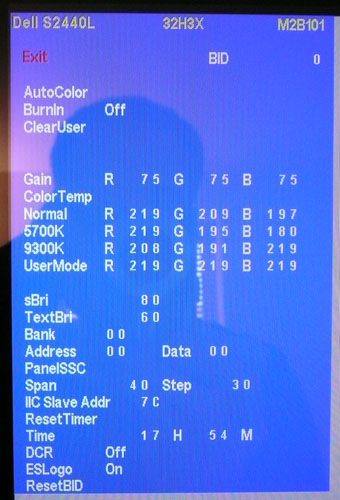
You can access the monitors factory menu as well
but be careful not to change anything without knowing what you've done or how to
change it back. Use the menu at your own risk! To access the factory menu, hold
the top two buttons down while powering the monitor on. Once it is on, press the
top button to bring up the menu. You can define the RGB levels for each of the
colour temp preset modes here and there are a few other settings relating to the
operation of the display. There is no control for the overdrive (OD)
impulse here which we have seen on some other Dell screens in the past so we
will be reliant on the manufacturers set up.
Overall the OSD menu offers a decent range of
options and it is intuitive and well structured. We are used to this menu as it
has been used on Dell monitors for a while now.

Power Consumption
In terms of power consumption the manufacturers spec states
typical
usage of 18W. In standby the screen apparently
uses <0.5W.
|
 |
|
State and Brightness
Setting |
Manufacturer Spec (W) |
Measured Power Usage
(W) |
|
Factory Default (75%) |
18.0 |
18.2 |
|
Calibrated (45%) |
- |
15.3 |
|
Maximum Brightness (100%) |
- |
20.0 |
|
Minimum Brightness (0%) |
- |
9.4 |
|
Standby |
<0.5 |
0.7 |
|
We tested this ourselves and found that out of the
box the screen used 18.2W of power while at its default brightness setting which
was 75%. At the lowest brightness setting, power consumption was reduced to
9.4W and at maximum 100% brightness it reached 20.0W. After calibration the
brightness setting had been adjusted to 45%
and the power consumption was measured at 15.3W. In standby the screen used
0.7W of power. We have plotted these measurements on the graph below for
comparison with other screens:


Panel and Backlighting
|
Panel Manufacturer |
AU Optronics |
Colour Palette |
16.7 million |
|
Panel Technology |
AMVA |
Colour Depth |
8-bit |
|
Panel Module |
M240HVN01 V0 |
Colour space |
Standard gamut, ~sRGB |
|
Backlighting Type |
W-LED |
Colour space coverage (%) |
~72% NTSC |
Panel and Colour Depth
The Dell S2440L utilises an
AU Optronics AMVA M240HVN01 V0 panel which is capable of producing 16.7
million colours with a true 8-bit colour depth. The panel is confirmed when
removing the back of the screen as shown below:
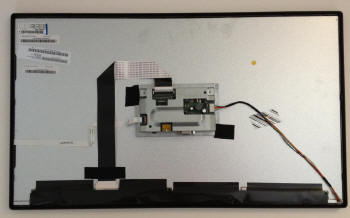
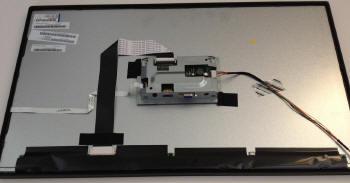
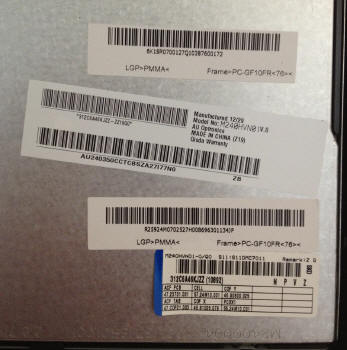
Above:
dismantled screen. Click for larger versions
Panel Coating
The
screen coating on the S2240L is a glossy solution. The panel surface itself
is glossy which you can see if you dismantle the monitor as it has no protective
coating applied to it. This is different to
other AMVA panels we have seen in the past which normally feature a light AG
coating. To the front of the screen an edge-to-edge glass
layer is added which increases the overall glossy feel of the screen and
provides protection for the panel. This is
very reflective, more so than some other glossy coated screens we have seen
before. Users
need to be careful when selecting a screen like this as windows, lighting or
lamps can become problematic depending on your working conditions. Smudges and
finger prints may also prove troublesome.
Backlighting and Colour Gamut
The S2440L uses
White-LED (W-LED) backlighting producing a colour space approximately equal
to the sRGB reference. This means the screen is considered a 'standard gamut'
backlight type. The gamut would cover approximately 72% of the NTSC reference
space. A wide gamut screen would need to be considered by those wanting to work
outside of the sRGB colour space of course.
PWM Flicker Tests at Various
Backlight Brightness Settings
100%
50%
10%

|
Pulse Width
Modulation Used |
No |
|
Cycling
Frequency |
n/a |
|
Possible
Flicker at |
|
|
100% Brightness |
No |
|
50% Brightness |
No |
|
10% Brightness |
No |
We tested the screen to establish the methods used
to control backlight dimming. Our recent article talks in more details about a
common method used for this which is called
Pulse Width Modulation (PWM). A series of photos was taken using the method
outlined in the article. These were taken at 100%, 50% and 10% brightness
settings. We would normally also test this at 0% brightness but the screen was
so dark it was hard to get a decent photograph. These tests
allow us to establish 1) whether PWM is being used to control the backlight, 2)
the approximate frequency at which this operates, and 3) whether a flicker may be introduced
or potentially noticeable at certain settings.
A thin white line was shown on an all-black
background and a photograph was taken at a slow shutter speed of 1/8 second (in
this example) as
the camera was scanned left to right in front of the screen. This produces a
series of white lines which can be used to identify the frequency of the PWM and
how quickly the backlight is cycled on and off. The higher this frequency, the
less likely you are to see artefacts and flicker. The duty cycle (the time for
which the backlight is on) is also important and the shorter the duty cycle, the
more potential there is that you may see flicker. Please remember that not every
user would notice a flicker from the backlight but it is something to be wary
of. It is also a hard thing to quantify as it is very subjective when talking
about whether a user may or may not experience the side effects. We are able to
at least measure the frequency of the backlight using this method and tell you
whether the duty cycle is sufficiently short at certain settings that it may
introduce a flicker to those sensitive to it.
Interestingly the Dell S2440L does not use PWM at
all for dimming of the backlight. Even at 0% brightness there was no sign of the
usual splitting of the white line that you'd expect to see in these tests. We
carried out the checks at an even slower shutter speed which returned the same
result. This is great news for those who are affected by flickering backlights
and suffer from eye fatigue and eye strain. It seems we have seen quite a few
new monitors recently which don't use PWM for backlight dimming. The
HP ZR2740w,
DGM IPS-2701WPH,
ViewSonic VP2770-LED,
Samsung S27B970D and
Dell U2713HM spring to mind as other models which do not use PWM which we
have tested recently.
Note 14/11/12 - We have had a few
users contact us in relation to their S2440L units with information suggesting
that they are perhaps using PWM for backlight dimming. These users have been
based elsewhere in Europe (Sweden and Germany) but it seems there may be some
units of this screen which do in fact use PWM. Other users, including review
site
pcmonitors.info have confirmed units without PWM. It seems that perhaps
there are different versions of this screen out there, and perhaps even some
panel swapping going on? I would like to make the point that PWM dimming does
not cause issues for most people, but I am including the note here for
completeness and while we try to gather additional information about the screen
and panels. If you are affected by PWM related issues, you may want to be
cautious about this screen at this stage.
If any owners of the S2440L can get in touch with
us to confirm their units that would be welcomed. Please try and run the PWM
tests described in
our article and take photos to test at various backlight levels. If any
users can also remove the back from their screen to confirm the panel part being
used, that would be very useful.

Testing
Methodology
An
important thing to consider for most users is how a screen will perform out of
the box and with some basic manual adjustments. Since most users won't have
access to hardware colorimeter tools, it is important to understand how the
screen is going to perform in terms of colour accuracy for the average user.
I
restored my graphics card to default settings and disabled any previously active
ICC profiles and gamma corrections. The screen was tested at default factory settings using the DVI interface, and analysed using
an
X-rite i1
Pro Spectrophotometer (not to be confused with the new i1 Display Pro
colorimeter) combined with
LaCie's Blue Eye Pro software suite. An NEC branded and customised X-rite i1 Display 2 colorimeter was
also used to verify the black point and contrast ratio since the i1 Pro is less
reliable at the darker end.
Targets for these tests are as follows:
-
CIE Diagram - validates the colour space
covered by the monitors backlighting in a 2D view, with the black triangle representing the
displays gamut, and other reference colour spaces shown for comparison
-
Gamma - we aim for 2.2 which is the default
for computer monitors
-
Colour temperature / white point - we aim
for 6500k which is the temperature of daylight
-
Luminance - we aim for 120
cd/m2, which is
the recommended luminance for LCD monitors in normal lighting conditions
-
Black depth - we aim
for as low as possible to maximise shadow detail and to offer us the best
contrast ratio
-
Contrast ratio - we aim
for as high as possible. Any dynamic contrast ratio controls are turned off here
if present
-
dE average / maximum -
as low as possible.
If DeltaE >3, the color displayed is significantly different from the
theoretical one, meaning that the difference will be perceptible to the
viewer.
If DeltaE <2, LaCie considers the calibration a success; there remains a
slight difference, but it is barely undetectable.
If DeltaE < 1, the color fidelity is excellent.

Default Performance and
Setup
IMPORTANT NOTE: Before we get into this
section we need to make an important note about use of the HDMI port. The
screen only features a single D-sub VGA and 2x HDMI port. Naturally you will
probably want to use the digital HDMI connection if you can for optimum
picture quality. If you have an NVIDIA graphics card and want to use the HDMI
at all, whether a straight HDMI > HDMI connection or a DVI > HDMI conversion,
you need to make a change to your graphics card settings to display the
optimum picture. This is because by default the output range over HDMI is
limited by the graphics card, and it can greatly limit the picture quality and
in particular the black range and contrast ratio.
When connected via HDMI on an NVIDIA graphics
card the screen by default will not look right, and the black range in
particular is poor. In fact we obtained static contrast ratios of only ~400:1
in the default mode before making this change and originally thought the
screen was at fault. A change is needed via your graphics card to
ensure a full 0 - 255 output when using HDMI, rather than it being limited to
a smaller output range of 16 - 235. This applies to NVIDIA cards but is only
necessary when connecting to the HDMI port on the screen and is not needed
when using D-sub. A similar change might be required when using an AMD
graphics card but the setting is built into their graphics card drivers we
believe. For NVIDIA cards the simplest way to ensure a full output range is to
use the handy toggle utility
available here.
If you run the program you can select a full 0- 255 range quickly and easily.
Anyway, default settings of the screen were as follows:
|
Monitor OSD Option |
Default Settings |
|
Brightness |
75 |
|
Contrast |
75 |
|
Picture mode |
Standard |
|
RGB |
n/a |

Dell S2440L - Default Factory Settings



|
|
Default Settings |
|
luminance (cd/m2) |
186.02 |
|
Black Point (cd/m2) |
0.06 |
|
Contrast Ratio |
3012:1 |
The default set of the screen felt ok to the naked
eye, perhaps a little cool, and as is normal for most screens it was too bright
for comfortable use. Colours appeared to 'pop' somewhat because of the glossy
screen coating and it felt different to models using AG coating. In terms of measurements, the
CIE diagram on the left confirms that the monitors colour gamut (black
triangle) matches the sRGB colour space (orange triangle) reasonably closely. It
extends a little past the sRGB space in some shades, particularly in blues, but falls a
little short in some others in greens in this 2D view of gamut. There is no sRGB
emulation mode on this model and so you cannot more closely match the sRGB space
than the native gamut of the backlight.

Default gamma was measured at 2.3 average, leaving
it 4% out from the target of 2.2. This was too high in darker shades, but a bit
closer to the 2.2 figure in lighter grey shades, as shown in the more detailed
table above. The white point was measured at 7003k, being 8% out from the target
of 6500k which wasn't too bad, but a bit cool. Colour accuracy was very good
with an average dE of 1.8 and maximum of 4.8. Colour gradients showed smooth
transitions in lighter shades, but at the darker end there was some gradation
and some banding evident. Luminance was too high as we had suspected, being
measured at 186 cd/m2
by default while at the 75% brightness setting. We achieved a very high static
contrast ratio of 3012:1 by default which was about what we'd expected from a
modern AMVA panel. These panels aren't quite living up to their 5000:1 spec yet
but this is still far more than any TN Film, IPS or PLS panel can offer. Once
again, you do need to change the colour format if you're using HDMI on an NVIDIA
card, otherwise contrast ratio will suffer massively.

Calibration Results
I wanted to calibrate and profile the screen to determine what was possible with optimum settings and
profiling. I used the
X-rite i1 Pro spectrophotometer
combined with the LaCie Blue Eye Pro software package to achieve these results
and reports. An NEC branded and customised X-rite i1 Display 2 was used to
validate the black depth and contrast ratios due to lower end limitations of the
i1 Pro device.

Dell S2440L - Calibrated Settings
|
Monitor OSD Option |
Calibrated Settings |
|
Brightness |
45 |
|
Contrast |
75 |
|
RGB Channels |
99, 92, 92 |
|
Preset Mode |
Custom Color |

|
|
Calibrated Settings |
|
luminance (cd/m2) |
121 |
|
Black Point (cd/m2) |
0.04 |
|
Contrast Ratio |
2954:1 |
I reverted to the 'custom color' mode in the
preset section of the OSD menu which would allow me access to the individual RGB channels.
Adjustments were also made during the process to the brightness control, and to
the RGB channels as shown in the table above. This allowed me to obtain an
optimum hardware starting point and setup before software level changes would be
made at the graphics card level which would help preserve tonal values. After this I let the software carry out the LUT adjustments and create an
ICC profile. The screen does not feature a hardware LUT calibration option
so other than the OSD alterations, the rest of the process is carried out at a
graphics card level in profiling the screen.
Average gamma had been corrected to 2.2 with 0%
deviance according to the initial test correcting the default 4% deviance we'd
found in this preset. The 8% deviance in the white point from our target
of 6500k had also been corrected here and the colour temperature was now pretty
much spot on at 6479k. Luminance had also been corrected thanks to the
adjustment to the brightness control, now being measured at 121
cd/m2. This
also gave us a calibrated black depth of 0.04 cd/m2, and an excellent
calibrated
static contrast ratio of 2954:1. Colour
accuracy had also been corrected nicely, with dE average of 0.6 and maximum of
1.3. LaCie would consider colour fidelity to be excellent now overall.
Testing the screen with various colour gradients
showed mostly very smooth transitions. There was some slight gradation in darker tones
and some very slight banding evident as we'd seen at default settings. Nothing
too major though that would be noticeable to most normal users. Unlike most
other panels in the market, this screen does not feature
anti-glare (AG) coating. Instead it uses a glossy screen coating and as a
result the colours look clean and crisp, the image quality is sharp and whites
in particular look a lot more pure than they do on heavy AG coated screens like
some of the IPS alternatives available. Glossy coating isn't to everyone's taste
though as it can introduce reflections which are annoying, particularly so on
this glass fronted model. You should probably try and see a glossy and an AG
coated panel in person if you are unsure what to buy.
You can use our settings and
try our calibrated ICC profile if you wish, which are available in
our ICC profile database. Keep in mind that results will vary from one
screen to another and from one computer / graphics card to another.

Calibration
Performance Comparisons
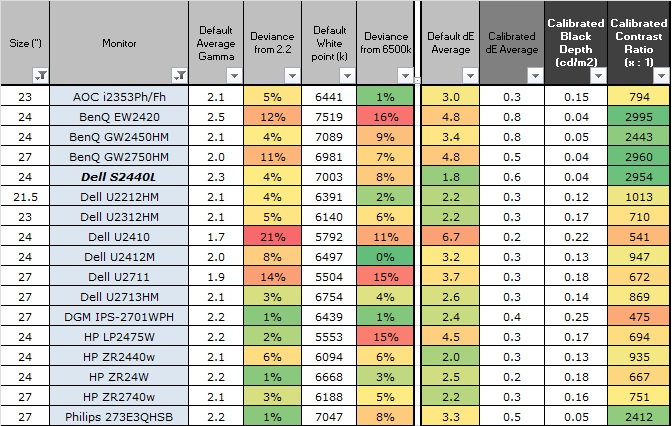
We've extended the comparisons made in this
section to try and give you a better view of how each screen performs,
particularly out of the box which is what is going to matter to most consumers.
When comparing the default factory settings for each monitor it is important to
take into account several measurement areas - gamma, white point and
colour accuracy. There's no point having a low dE colour accuracy figure if the
gamma curve is way off for instance. A good factory calibration requires all 3
to be well set up. We have deliberately not included luminance in this
comparison since this is normally far too high by default on every screen.
However, that is very easily controlled through the brightness setting (on most
screens) and should not impact the other areas being measured anyway. It is easy
enough to obtain a suitable luminance for your working conditions and individual
preferences, but a reliable factory setup in gamma, white point and colour
accuracy is important and not as easy to change accurately without a calibration tool.
From these comparisons we can also compare the
calibrated colour accuracy, black depth and contrast ratio. After a calibration
the gamma, white point and luminance should all be at their desired targets.
Default setup of the S2440L was pretty good when
it comes to gamma and white point. There was a small 4% deviance in gamma and a
slightly higher 8% deviance in white point. This represented a pretty good
factory setup, much like we'd seen from the Dell U2212HM, U2312HM and U2412M.
Colour accuracy was also very good with dE average of 1.8, again close to what
we'd seen from the U2212HM and U2312HM, and a little better in fact than the
U2412M.
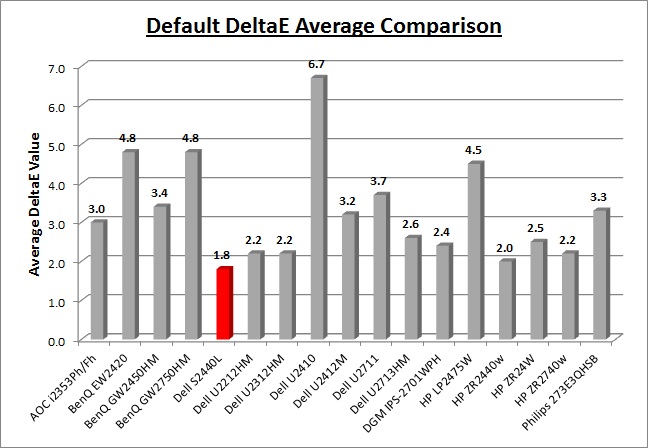
Default colour accuracy is compared again on the
above graph, with the S2440L having a very reliable default setup which is
pleasing, especially given the low cost of this model.
Once calibrated the dE average was reduced to 0.4.
This would be classified as excellent colour fidelity by LaCie. It was not quite
as low as some of the other screens here which reached down to 0.2 average, but
in practice you would not notice any difference here at all. The professional
range models from NEC and Eizo are even more accurate than other
models shown here. Professional grade monitors like those offer other high end
features which separate them from some of these other models, including extended
internal processing, 3D LUT's and hardware calibration. These comparisons are
based on a small selection of tests, so it should be remembered that other
factors do come into play when you start talking about professional use.
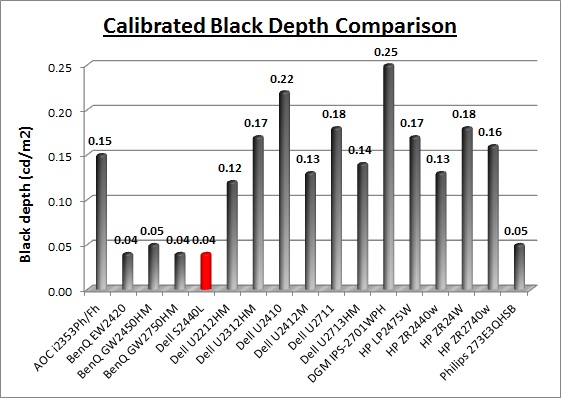
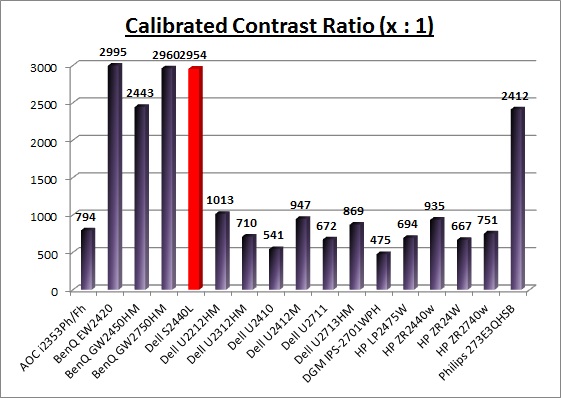
The calibrated black depth and contrast ratio of
the S2440L were excellent, with a static contrast ratio on par with the other
AMVA panels we've tested at 2954:1. This is much higher than we have seen from
any IPS, TN Film or PLS panel and is certainly a strong point of AMVA
technology.
|
 |
This review had been made available to
download and save
in PDF format (.pdf) allowing you to:
-
Save a copy for personal use and
archiving
-
Save and read our reviews offline
-
Read our reviews on your eBook
reader (e.g. Kindle, iPad and other tablets)
Please
visit our Store
for more information and to download a copy. A small fee will contribute
towards the running of TFTCentral and allow us to continue to make high
quality and detailed reviews in the future. |

Contrast
Stability and Brightness
I wanted to see how much variance there was in the screens contrast as we
adjusted the monitor setting for brightness.
In theory, brightness and contrast are two independent parameters, and good
contrast is a requirement regardless of the brightness adjustment.
Unfortunately, such is not always the case in practice. We recorded the
screens luminance and black depth at various OSD brightness settings, and
calculated the contrast ratio from there. Graphics card settings were left at
default with no ICC profile or calibration active. Tests were made using an
NEC branded and customised
X-rite i1 Display 2 colorimeter. It should be noted that we used the
BasICColor calibration software here to record these, and so luminance at
default settings may vary a little from the LaCie Blue Eye Pro report.
|
OSD Brightness |
Luminance
(cd/m2) |
Black Point (cd/m2) |
Contrast Ratio
( x:1) |
|
100 |
192.96 |
0.06 |
3216 |
|
90 |
188.00 |
0.06 |
3133 |
|
80 |
182.20 |
0.06 |
3037 |
|
70 |
169.32 |
0.05 |
3386 |
|
60 |
150.51 |
0.05 |
3010 |
|
50 |
130.73 |
0.04 |
3268 |
|
40 |
110.85 |
0.04 |
2771 |
|
30 |
91.44 |
0.03 |
3048 |
|
20 |
71.16 |
0.02 |
3558 |
|
10 |
50.36 |
<0.02 |
- |
|
0 |
30.01 |
<0.02 |
- |
|
Total Luminance Adjustment Range = 162.95 cd/m2
Total Black
Point Adjustment Range = > 0.04 cd/m2
Average
Contrast Ratio = 3159:1
Recommended OSD setting for 120 cd/m2 = 44%
|
The luminance range of the screen was good. At the
top end the panel reached 192.96
cd/m2 which was actually a fair bit
short of the
specified maximum of 250 cd/m2, but probably fine for most users as
an upper limit. At the lower adjustment end it could
reach down to a very low 30.01 cd/m2 meaning the screen should be
perfectly fine even in darkened room conditions, and for those who like to run
at a lower luminance setting. A brightness setting of ~44% should return you a
default luminance of around 120 cd/m2 as well. Black point remained
very low across the adjustment range, from 0.06 cd/m2 down to below 0.02 cd/m2,
the lower limit of the X-rite i1 Display 2 device.

We have plotted the
luminance trend on the graph above. The screen behaves as it should, with a
reduction in the backlight intensity controlled by the reduction in the OSD
brightness setting. This was not a linear relationship overall as the
adjustment range from 100 to 80% showed a smaller actual change in the overall
luminance than each additional step. The change was steeper from 80% downwards
as you can see from the graph above.
We will not provide our usual
contrast stability graph since the low black levels mean that the rounding
errors are too high and it would not fairly represent the stability of the
contrast. Average contrast ratio measured was ~3159:1 which was excellent.

Dynamic Contrast
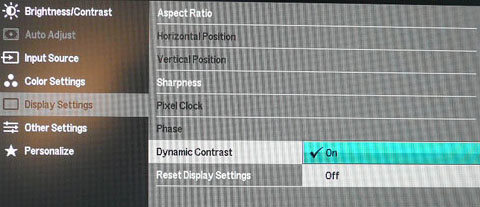
The Dell S2440L features a dynamic contrast ratio
(DCR) control, which boasts a spec of 8,000,000:1 (8 million:1). Dynamic
contrast ratio involves controlling the backlight of the screen automatically,
depending on the content shown on the screen. In bright images, the backlight
is increased, and in darker images, it is decreased. We have come to learn
that DCR figures are greatly exaggerated and what is useable in reality is
often very different to what is written on paper or on a manufacturers
website.
For this test I would use the colorimeter to record the
luminance and black depths at the two extremes. Max brightness would be
recorded on an almost all white screen. Black depth would
be recorded on an almost all black screen. In real use you are very
unlikely to ever see a full black or full white screen, and even our tests are
an extreme case to be honest. Carrying out the tests in this way does give you
a good indication of the screens dynamic contrast ratio in real life
situations however.

The DCR feature is available in only the movie
and game preset modes, and for some reason not in the multimedia preset. It
has a simple setting for on or off and once enabled you cannot control the
brightness setting manually. If you do try to change it you are given the
above warning and the option to turn the DCR feature off.
|
|
Dynamic Contrast |
|
Specified DCR Range |
8 million: 1 |
|
Available in Presets |
movie, game |
|
Settings |
On / Off |
|
Max luminance (cd/m2) |
187.20 |
|
Min Black Point (cd/m2) |
0.06 |
|
Max Dynamic Contrast Ratio |
3120:1 |
We tested the DCR feature and you could
immediately notice the screen getting much brighter when you first turn it on
compared with the standard preset. You can observe the changes being made in the
OSD by looking at the energy meter in the top right hand corner. Switching to
this mode in normal office-type applications showed the energy bar fill up to
maximum, indicating that the brightness was being turned up to a high setting.
When switching between an almost all-white and an almost all-black screen there
was no change at all to the luminance of the screen, detectable either to the naked eye
or by looking at the energy meter. As a result, we didn't obtain a contrast
ratio any higher than we'd seen from our static
contrast ratio tests before.
We tested the screen with a
completely black screen as well and you could tell from the OSD energy meter
that it was then able to control the backlight a bit, down to around the 50% setting by the look of things.
This would in theory give you a better DCR of around 4800:1 but it should be
noted that it would be extremely rare to ever see a 100% black image in real use
and so this is more of a theoretical DCR than a realistic, practical DCR.
You'd have to be turning
the backlight completely off on an all-black image to achieve anything higher
really here and anything near the crazy spec being quoted. Some screens do
actually do that which allows for exaggerated laboratory testing and their
resulting specs, but in the case of the S2440L it was not turning the backlight
off. In normal use, the DCR is pretty much useless.

Viewing Angles

Above: Viewing
angles shown from front and side, and from above and below. Click for
larger image
Viewing angles of the S2440L were
characteristic of an AMVA panel. Horizontally they were reasonably wide although
there was a contrast shift from an angle of >40° either side which made the
image go pale and yellow quite noticeably. From a wider angle still the image
had a more pronounced pale tinge to it and you can pick this out from the
images above. Vertically they were a bit more restrictive still with a fairly
noticeable contrast shift detectable with even a slight movement up or down, and
a pale tinge to the image being more obvious. This was also a little yellow from
a wider angle, and this is brought out in the photos above. The viewing angles were
certainly better than TN Film matrices in these regards, and free of the obvious
vertical darkening you see from TN Film technology. However, they were not as
wide as IPS or PLS matrices and the contrast shifts were more noticeable
unfortunately.
There was also a pretty obvious off-centre
contrast shift which is inherent to VA panel types. Using a test image which
shows a dark grey font on a black background you can easily test this 'feature'.
From head on, the text was invisible and largely lost within the black
background. This is down to the pixel alignment in a VA matrix. As you move away
from a central line of sight the text becomes lighter and is more easily
visible, especially from an angle of about 45°. This is an extreme case of
course as this is a very dark grey tone we are testing with. Lighter greys and
other colours will appear a little darker from head on than they will from a
side angle, but you may well find you lose some detail as a result. This can be
particularly problematic in dark images and where grey tone is important. It is
this issue that has led to many graphics professionals and colour enthusiasts
choosing IPS panels instead, and the manufacturers have been quick to
incorporate this alternative panel technology in their screens. I would like to
make a point that for many people this won't be an issue at all, and many may
not even notice it. Remember, many people are perfectly happy with their TN Film
panels and other VA based screens. Just something to be wary of if you are
affected by this issue or are doing colour critical work.
_small.JPG)
Above: View of an all black screen from the side. Click for larger version
On a black image there is a slight pale and purple/blue
tint introduced to the image when viewed from a wide angle. This isn't too
severe and shouldn't present any real problems in practice.

Panel Uniformity
Measurements of the screens luminance were taken
at 35 points across the panel on a pure white background. The measurements were
taken using BasICColor's calibration software package, combined with the NEC
customised X-rite
i1 Display 2 colorimeter. The above uniformity diagram shows the difference, as
a percentage, between the luminance recorded at each point on the screen, as
compared with the reference point of a calibrated 120 cd/m2. This is
the desired level of luminance for an LCD screen in normal lighting conditions,
and the below shows the variance in the luminance across the screen
compared with this point. It is worth noting that panel uniformity can vary from
one screen to another, and can depend on manufacturing lines, screen transport
and other local factors. This is only a guide of the uniformity of the sample
screen we have for review.
Uniformity of Luminance

The overall uniformity was good here. There
was a slight drop in luminance down to 104
cd/m2 along the left hand edge but
overall around 83% of the screen was within 10% deviance of the central 120
cd/m2 measurement. A decent performance here really given the low
cost of the screen.
Backlight Leakage
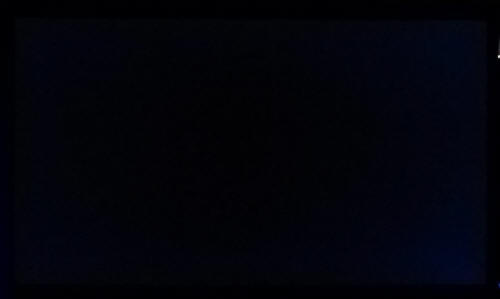
Above: All black screen in a darkened room. Click for larger version
As usual we also tested the screen with an all
black image and in a darkened room. A camera was used to capture the result.
There was no major backlight leakage although there was some slight clouding in the
bottom right hand corner which the camera picked up in the photo above. This shouldn't
present any real problem in practice though and it was quite minimal. Again a
good performance here from the S2440L. We should note that we actually had
chance to test two random stock samples of this screen and found both to return
similar results as above in terms of backlight leakage.

General and Office Applications
The S2440L offers a variable performance when it
comes to office work. Firstly the 1920 x 1080 resolution and 24" screen
size give a nice decent area in which to work although the vertical resolution
is a little less than 16:10 aspect 24" models (1920 x 1200). I think you notice
this if you come from a 16:10 format screen. Also consider the fact that high
resolution 27" 2560 x 1440 models are becoming increasingly available and
so the
difference in desktop size is certainly noticeable coming from a 27" screen like
that. Nevertheless, the 24" 1920 x 1080 resolution should be adequate for many
users. The screen offered a comfortable 0.277mm pixel pitch which delivered easy
to read text at a nice size, in my opinion. The resolution is certainly big
enough for side by side split screen working as well in many cases.
One area which raises questions here though is the
glossy screen coating and glass front. While the screen might look attractive
sat on
the desk, it can become a little tricky to use in certain conditions. The
glossy coating does help with the 'feel' of the images and colours and blacks
can 'pop' when it is used by display manufacturers. However, reflections become
quite a problem, and on the S2440L the glossy-ness seemed to be quite severe.
You need to be very careful about the position of your screen with your
surrounding light sources, otherwise reflections become a pain. This might not
be a problem for many users, and it's the same issue you'd face with any glossy
screen really. For office work personally I found it a bit difficult.
Default luminance of the screen is a little too
high at around 186
cd/m2 at the default 75% brightness setting. You will probably want
to turn this down to around 44% for a comfortable luminance around 120 cd/m2.
Those wanting to use the screen in low lighting conditions shouldn't have any
issue here as the brightness control offers an excellent adjustment range, down
to ~30 cd/m2 in fact. The default colour, white point and gamma setup
are very good thankfully so even without a colorimeter device you should be able
to achieve decent performance from the screen easily. Another thing to note
while we are talking about the brightness control is that the screen does not
use
Pulse-Width modulation (PWM) to control backlight dimming and so those who
suffer from eye fatigue or headaches associated with flickering backlights need
not worry here. (Note 14/11/12 see our panel section for an update on this)
There is a specific preset mode for 'text' in the
OSD menu which accentuates the sharpness of the image. This seems to enable the
'image enhance' feature (which is then greyed out) which in my opinion makes the
text and image look too sharp and a bit unrealistic. The normal standard or
custom color preset modes would be better, with image enhance left off. The
default sharpness setting of 50 in the OSD also seemed optimal.
I tested the screen with both HDMI and D-sub
interfaces, and the HDMI digital signal was a little sharper than VGA. You will want to
use HDMI for the sharpest text and image where possible (making sure to
adjust your
graphics card settings if using an NVIDIA card and HDMI). There are no USB
ports featured on this model since Dell have trimmed down the features to keep
costs low. Those can be pretty handy for connecting external devices, so it's a
bit of a shame to see them gone. The stand is also very basic, offering only a
tilt adjustment. While this is easy to use, the height, swivel and even rotate
adjustments are missed I think for office uses and the screen is perhaps a
little too low as a result.

Above: photo of
text at 1920 x 1080 (top) and 1600 x 900 (bottom)
The screen is designed to run at its native
resolution of 1920 x 1080 and at 60Hz refresh rate. If you want to you can run
it outside of this and let the image be scaled to fill the screen. At the native
resolution text was sharp and clear. We ran the screen at 1600 x 900 which
was the next step down, while still maintaining the screens 16:9 aspect ratio.
Text was more blurred and you do
take a hit in terms of resolution of course. To give you
more desktop real estate and maximum picture quality, the native resolution is
of course recommended where possible.

Responsiveness and Gaming
The S2440L is rated by Dell as having a 6ms G2G response time which implies the use of
overdrive /
response time compensation (RTC) technology. This is used to boost pixel
transitions across grey to grey changes and improve responsiveness in practice,
and reduce ghosting and blurring. The panel being used is an
AU Optronics AMVA M240HVN01 V0 Panel. We have seen mixed performance in the
past from AMVA panels, with older versions being inherently very slow and
showing quite noticeable blurring and ghosting in these tests. Some recent AMVA
panels have made improvements, so let's hope for the same here from the S2440L.
It should be noted that unlike some other Dell screens, you cannot turn the
overdrive control on and off from within the
factory OSD and so we are reliant
on Dell's setup here.
Display Comparisons
The screen was tested using the chase test
in PixPerAn for the following display comparisons. As a reminder, a series of pictures are
taken on the highest shutter speed and compared, with the best case example
shown on the left, and worst case example on the right. This should only be used
as a rough guide to comparative responsiveness but is handy for a comparison
between different screens and technologies.

24" 6ms G2G AU
Optronics AMVA
In practice the Dell S2440L showed pretty low
levels of motion blur and it was free from the obvious ghosting and blurring you
can see from some older AMVA panels. Movement was pretty smooth and the image
looked sharp. There was a fairly noticeable dark trail introduced however which
is caused by an overshoot of the overdrive impulse. This overdrive is being
applied too aggressively and is causing the pixels to overshoot their desired
orientation, producing a dark trail in these tests. This is noticeable to the
naked eye although not too severe.

24" 6ms G2G AU
Optronics AMVA

24" 8ms G2G
LG.Display e-IPS

23" 8ms G2G
LG.Display e-IPS

24" 6ms G2G LG.Display H-IPS
I have provided first of all a comparison of the
S2440L against 3 other Dell screens. We had seen some similar dark trailing on
the
Dell U2412M as well which you can see from the above images. It is perhaps a
little more obvious on the S2440L but both models seem to suffer from a poorly
controlled overdrive impulse. It was a similar story with the
23" U2312HM as well. You can eliminate that on the U2412M and U2312HM by
turning the overdrive control off in the factory OSD, but at the cost of
overall responsiveness. The older 24"
Dell U2410 showed good response times with low levels of blur (not quite as
low as the U2412M), and also freedom from these dark overshoot artefacts.

24" 6ms G2G AU
Optronics AMVA

24"
8ms G2G AU Optronics AMVA (AMA setting = On)

24" 4ms G2G AU
Optronics AMVA (AMA = Premium)
If we compare the S2440L with two other 24" AMVA
panels we have tested, the differences become more obvious. The
BenQ EW2420 was the first AMVA + W-LED on the market and its older
generation AMVA panel was very slow. There is obvious blurring and ghosting in
practice and it wasn't suitable for gaming as a result. Big improvements were
made by the time we tested the
BenQ GW2450HM more recently, with responsiveness finally reaching the kind
of levels you'd see from competing IPS panels. Blurring was greatly reduced
although there was some slight dark overshoot here. The Dell S2440L performs
quite similarly to the GW2450HM in terms of blur, but the dark overshoot is more
pronounced.

24" 6ms G2G AU
Optronics AMVA

24" 2ms G2G AU
Optronics TN Film + 120Hz (AMA = On)

27" 1ms G2G Chi
Mei Innolux TN Film + 120Hz (Over Drive = 0)

22" 3ms G2G Samsung TN Film + 120Hz
We've also included a comparison above against
three very fast 120Hz compatible screens we have tested. In all cases these
other screens are using TN Film panels and are aimed primarily at gamers.
Firstly there is a comparison against the
BenQ XL2420T. This showed very low levels of motion blur, but some dark
overshoot was introduced as a side-effect. The
Iiyama G2773HS was very responsive and even has a quoted 1ms G2G response
time. This showed very low levels of blur and had minimal issue with overshoot.
The
Samsung SM2233RZ performed very well in these tests and showed very low
levels of motion blur also. When 120Hz mode was enabled the overdrive artefacts
evident in 60Hz mode were almost completely eliminated, which is something we
have seen with the BenQ XL2420T as well.
While these pixel response tests show the S2440L to
have pretty fast transitions and low levels of motion blur (albeit with some
overshoot), there is something else going on as well here which can't be picked out by the camera. All of these other TN Film models are
running at 120Hz refresh rates, which allows for improved 120fps frame rates and
the support of
3D stereoscopic content as well. This can really help improve smoothness and
the overall gaming experience so these screens still have the edge when it comes
to fast gaming. From a pixel response point of view the S2440L performed very
well, but there are some other areas you still need to think about when it comes
to high end gaming. It couldn't keep up with the very fast TN Film models with
120Hz support.
The responsiveness of the S2440L was pretty good
overall. Thankfully although it was based on an AMVA panel it performed much
better than older generation panels, and up to the standards we'd seen from a
couple of recent models. The blurring was at a low level but unfortunately
Dell's overdrive controlled seemed to be a little variable. A dark overshoot artefact
was fairly pronounced, a little more than the recent U2412M and U2312HM in fact
which had suffered in the same way. Overall it should still be fine for most
normal users.
Additional Gaming Features
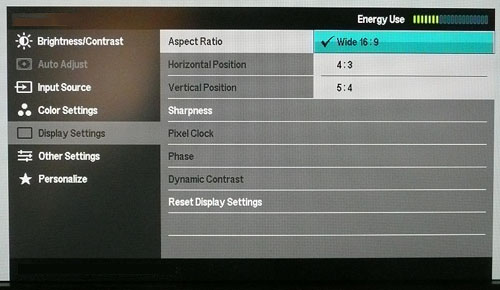
Aspect Ratio Control - The screen offers
three options within the OSD menu for hardware level
aspect ratio control. There are options to maintain the aspect ratio at
16:9, 4:3 or 5:4 ratios which should be adequate for most users and for the
connection of most external devices. It would have perhaps been useful to see an
"auto" mode, capable of detecting and maintaining the source aspect ratio
automatically, and perhaps a 1:1 pixel mapping mode for those who didn't want
the source image stretched at all. Each of the modes provided would stretch the
source image to fill as much of the screen as possible, but will maintain the
selected aspect ratio. In addition even if the input source is not one of the
specific aspects listed, it will be forced to that aspect if you select it. For
instance if you input the native 1920 x 1080 resolution, but select 4:3 aspect,
it will squash the screen sideways to meet a 4:3 aspect, but the image will just
be squashed accordingly. It can be a little annoying having to manually change
the aspect ratio each time if you input different aspect sources.
Preset Modes - There is a 'game' preset
mode available from within the preset mode menu. This seems to be a little
warmer than the standard preset mode. We've already established that the DCR doesn't offer
anything in real use sadly. The game preset mode also seems to accentuate
the sharpness setting. This mode might be useful if you want
to set up a specific mode to be different to your day to day normal use profile
as well.

Input Lag
We have recently written an in depth article about
input lag and the various measurement techniques which are used to evaluate
this aspect of a display. We have also improved our method by adopting the SMTT
2 (now version 2.5.1) tool which is used to generate the results below. Please
see our full
input lag testing article for all the details.
Input Lag Classification
To help in this section we will also introduce a broader classification system
for these results to help categorise each screen as one of the following levels:
-
Class 1)
Less than 16ms / 1 frame lag - should be fine for gamers, even at high levels
-
Class
2)
A lag of 16 -
32ms / One to two frames - moderate lag but should be fine for many gamers.
Caution advised for serious gaming and FPS
-
Class
3)
A lag of more
than 32ms / more than 2 frames - Some noticeable lag in daily usage, not
suitable for high end gaming
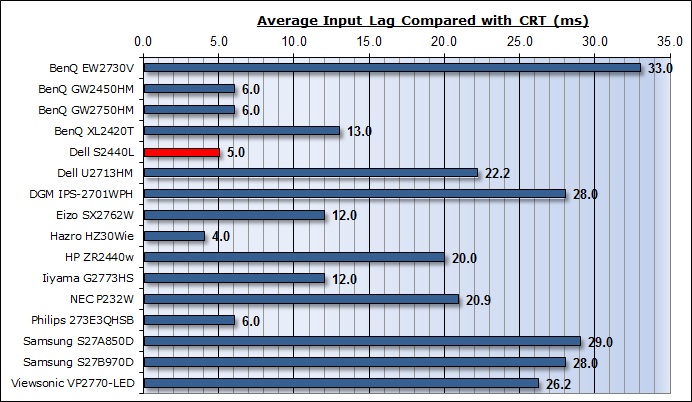
For the full reviews of the models compared here and the dates they were written
(and when screens were approximately released to the market), please see our
full
reviews index.
Our tests here are based on the new format using
SMTT 2.0. We have provided a comparison above against other models we have
tested to give an indication between screens. We have only included screens
which were tested using this new method to allow for a fair and realistic
comparison, and have removed any models tested using the old method.
The Dell S2440L shows a very low level of input
lag. This was measured at 5ms average. Note that this
is the overall display lag, and so accounts for the signal processing time + an
element of the pixel response time. The lag of this screen has been categorised
as CLASS 1 as detailed above. It should be perfectly fine for gaming as a
result, even for fast paced FPS.

Movies and Video

The following summarises the screens performance
in video applications:
-
24"
screen size makes it a pretty small option by today's standards for an all-in-one multimedia screen, being quite a bit smaller than modern LCD TV's and many other
desktop monitors now available.
-
16:9
aspect ratio is more well suited to videos than a 16:10 format screen, leaving
smaller borders on DVD's and wide screen content.
-
1920 x
1080 resolution can support full 1080 HD resolution content
-
Digital HDMI interface supports HDCP for any encrypted
and protected content
-
There
is no additional DVI port available, only 1x HDMI and 1x VGA. While it's
useful to have HDMI for connecting external devices, you would then be limited
to using VGA for your PC. An extra DVI port or a second HDMI would have been
useful here.
-
Glossy
AG coating and glass front may cause issues with reflections depending on
ambient lighting conditions. This could prove annoying in darkened rooms
depending on the position of your light sources.
-
Wide
brightness range adjustment possible from the display, including reasonable
maximum luminance of ~193
cd/m2 and very good minimum luminance
of ~30 cd/m2. Should afford you very good control for different
lighting conditions.
-
Black
depth and contrast ratio are excellent from the AMVA panel. Shadow detail in
darker scenes should not be lost.
-
Dynamic contrast ratio doesn't really work at all on this model, in case there's those who
like the feature.
-
'Movie' preset mode available which exaggerates the sharpness and colours,
making them look more vivid. Might be preferable to some users compared with a
normal PC setup mode.
-
Good
pixel responsiveness which should be able to handle fast moving scenes in
movies without issue. Perhaps some issues apparent with overshoot in certain
transitions.
-
Good
hardware level aspect ratio control options which may be useful for connection
of external devices, DVD players etc. Options for 16:9, 4:3 and 5:4 should
satisfy most uses. A 1:1 pixel mapping mode or an "auto" aspect ratio retention might have
been useful.
-
Wide
viewing angles thanks to AMVA panel technology meaning several people could
view the screen at once comfortable and from a whole host of different angles.
The off-centre contrast shift inherent to VA panels may prove a problem in
darker scenes where shadow detail could be lost depending on your line of
sight. You may find yourself moving your head to see some of the detail in
darker content if you are facing the screen head on.
-
Limited
range of ergonomic adjustments available from the stand with only tilt
available. Might be difficult to obtain a comfortable position for multiple
users or if you want to sit further away from the screen for movie viewing.
-
No
significantly noticeable backlight leakage, and none from the edges which is
good. This type of leakage may prove an issue when watching movies where black
borders are present but it is not a problem here.
-
No
integrated stereo speakers on this model but an audio output is provided to
take sound from the HDMI if it's being used.
-
Make
sure you
adjust your graphics card settings if using HDMI from an NVIDIA card to
get the full range and proper contrast ratio.
-
Picture in picture (PiP) or Picture By Picture (PbP) is not available on this
model.
-
For
PAL sources, we have tested the screen and confirmed it will support
the full native resolution of 1920 x 1080 at 50Hz refresh rate.
|
 |
This review had been made available to
download and save
in PDF format (.pdf) allowing you to:
-
Save a copy for personal use and
archiving
-
Save and read our reviews offline
-
Read our reviews on your eBook
reader (e.g. Kindle, iPad and other tablets)
Please
visit our Store
for more information and to download a copy. A small fee will contribute
towards the running of TFTCentral and allow us to continue to make high
quality and detailed reviews in the future. |

Conclusion
The Dell S2440L is an interesting addition to the
Dell monitor range. It's nice to see Dell try to fill a middle ground between
their low cost office TN Film monitors and their more expensive high-end
UltraSharp models and offer something a little different. These new S-line
models come with a new design and many users will like the glossy plastics and
the glossy glass screen coating. They certainly look nice on your desk, although
we would certainly advise caution given the reflective nature of the glass
front. The screen also offers a pretty reasonable spec and the use of an AMVA
panel is an interesting change for Dell from their 24" IPS models they have on
offer.
From a performance point of view, default factory
setup was very good and should provide a decent performance for normal users
without access to calibration tools. Black depth and contrast ratio were
excellent as well which you would expect from a modern AMVA panel, and something
which IPS technology cannot compete with at the moment. It was good to see PWM
was not being used for backlight dimming as well on our sample, a positive trend we hope to
see more of in the market. Pixel response times were also good and thankfully it
offers faster performance than older generation AMVA models. With a very low
input lag, this could handle gaming pretty well too. You do of course have to
live with the AMVA viewing angles which can be a bit restrictive.
Obviously Dell have cut back a few things to try
and offer a very low price. The screen
retails for ~£198 GBP (inc VAT) which makes it a little cheaper than the
Dell U2412M (£220) and U2410 (£360). It has a far more basic stand with only
tilt being available, so you need to think about whether you need more or not.
There are also more limited connections with the screen missing DVI and USB
which could have been handy. Having said that, the touch sensitive buttons add a
bit of a premium feel, and the overall glossy edge-to-edge design helps avoid it
feeling cheap at all which is great news. From the two samples we tested we were
pleased with the build quality and lack of backlight bleed as well which is
hopefully a good sign of the quality of these screens. The S2440L offers a
decent alternative in the AMVA screen offerings and the glossy coating is bound
to attract some buyers.
|
Pros |
Cons |
|
Excellent black depth and
contrast ratio from AMVA panel |
May be too glossy and
reflective for some users |
|
Very good default factory
setup |
Limited ergonomic adjustments,
only tilt available |
|
PWM not used for backlight
dimming
(14/11/12 - see panel section for update) |
Limited connectivity options |
|
 |
If you have enjoyed
this review and found it useful, please consider making a
small
donation to the site. |